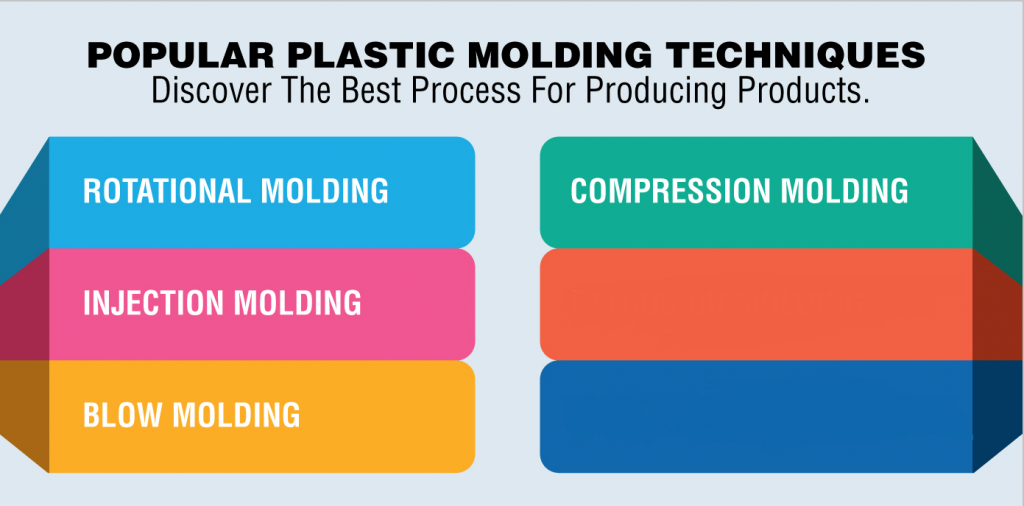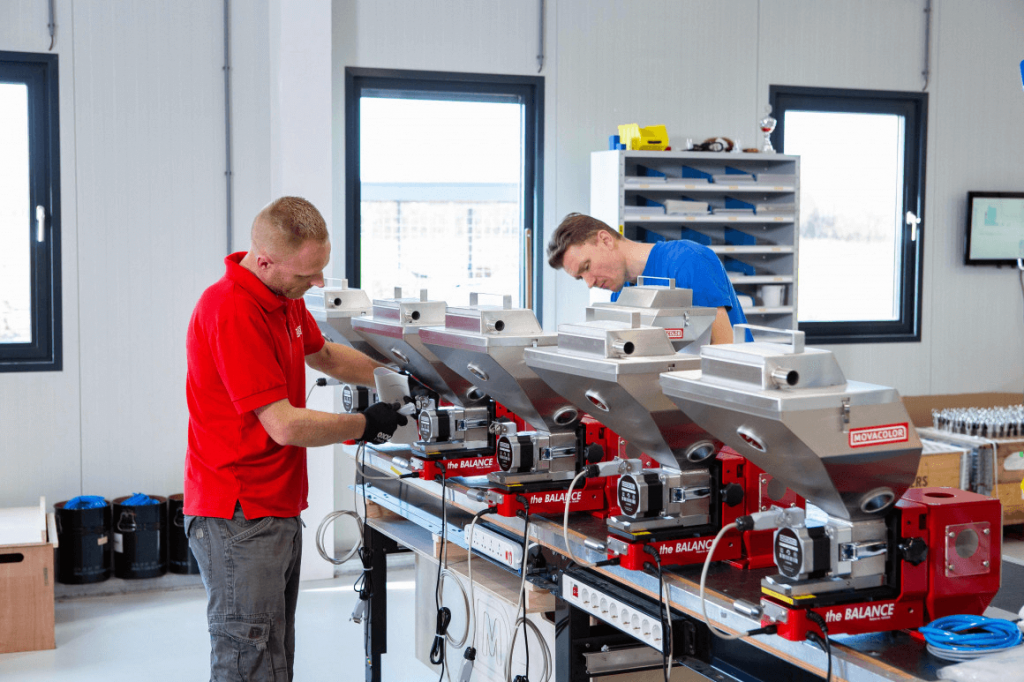プラスチック金型メーカー:さまざまな成形技術
プラスチック金型メーカー:プラスチック成形の種類
プラスチック金型メーカーに連絡する最も明白な理由は次のとおりです。 カスタムプラスチック製品または部品のいずれかが必要です。 プラスチックを成形する方法はいくつかあり、それぞれに長所と短所があります。
さまざまなプラスチック成形技術の基本を理解している場合は、製品に適したものを選択できます。 それを説明する前に、パーツまたはコンポーネントの設計をそのままにしておく必要があります。
Here are the top 10 designing tips that will help you create effective and efficient products.
Now that your design is ready, let us move onto the phase of choosing the right moulding technique. In this blog post, we are going to talk about different plastic moulding techniques.

Plastic Die Mould Manufacturer Offers the Following Moulding Techniques
There are several plastic moulding techniques however, the most popular ones are listed below.
- Compression Moulding
- Blow Moulding
- Injection Moulding
- Rotational Moulding
We will be covering these techniques, their uses, and advantages.
Rotational Moulding
If your objective is to produce large hollow parts, we recommend using the Rotational Moulding technique. Manufacturers also refer to this technique as the rotomolding technique. It involves placing either liquid or powder into a metal mold.
After sealing the mold, place it in the oven and rotate it until the resin insides melt it. The constant rotation of the mold would create the centrifugal force, thus resulting in even-walled products. Wait for the mold to cool down, then remove the plastic.
It would be in the desired shape. The great thing about rotational moulding is that very little material is wasted. It is possible to reuse the excess material, thus making the process environmentally friendly and economical.
Rotational Molding: Common Use
Rotational molding is useful for creating hollow plastic products like storage tanks, bulk containers, car parts, pet houses, marine buoys, recycling bins, playground slides, kayak hulls, and road cones, etc.
Cost-Effective and Highly Customizable
With rotational moulding it is possible to alter the mold to a great extent. The mold flexibility facilitates the moulding a wide range of products. It is possible to include contours, curves, inserts as well as slots and logs for both metal and plastic moulding.
Rotational moulding is inexpensive in comparison to the blow molds. The reason being, rotation moulding requires lower starts up costs. It is highly effective and cost-efficient if you plan to produce limited numbers of parts of components.
Rotational molding would be cost-effective even if you want to produce as low as 25 parts.
Best Use of Rotational Moulding
The moulding technique is effective and cheap if you want to manufacturer a smaller number of parts. It works best for producing 25 to 1000 parts every year. The size of the parts can be medium or large. Of course, you can produce small parts as well.
However, the technique yields the best results for large or medium size parts.
Common Products
- Marine Bouys and Kayaks
- Car Parts
- Road Cones
- Storage Bins or Recycling Bins
- Utility Carts
Injection Molding
Another effective and hugely popular plastic moulding technique is injection moulding. A plastic die mould manufacturer would insert a molten plastic into a metal mould while using high pressure. Like all other forms of plastic moulding, you would have to wait for the mould to cool down before you take the plastic part out.
Once the mould is cooled, the molten plastic inside is also cooled down, thus forming the desired shape. This process is similar to that of the Jello Mould. The Jello process requires filling and then cooling for the product to take the shape.
Injection Molding Common Uses
Injection Moulding is highly effective for mass production of custom plastic parts. It is even useful for creating car parts as there are big size injection moulding machines available for this particular purpose. Likewise, there are smaller machines that can produce precise, and robust surgical applications.
Injection moulding offers flexibility for engineers and designers as it offers material versatility. Unlike most plastic moulding techniques, injection mould allows a wide of materials.
Although, Injection moulding offers versatility, but do bear in mind that aluminum or stool moulds are expensive. The upfront cost of these molds is high. Therefore, it is recommended to use injection moulding for mass production.
In addition, with injection moulding, the production time is longer. It requires around 6 to 12 weeks for the mould to be ready and then an additional 4 weeks for the manufacturing process.
Best Use of Injection Moulding
Injection Moulding is a highly effective moulding technique, especially when you need to do mass production. It would be cost-effective if you want around 30,000 pieces per year.
Common Products
- Plastic Bottle Caps
- Medical Devices
- Electrical Switches
- Bumpers
- Auto Dashboards

Blow Moulding
For thin-walled, hallow custom plastic parts, a plastic die mould manufacturer would recommend blow moulding. This technique is effective for parts where maintaining the shape is imperative. Therefore, it ensures a uniform thickness of the product wall.
The process has the same concept as that of the glass blowing. The technique involves heating the plastic and then blowing hot air up the plastic like a balloon. You blow the plastic in the mould, it takes the shape as it goes on.
Once the plastic balloon fills the mould, you need to wait for it to cool down. After it is being cooled, eject the plastic. It would be in the desired shape. The process is fast and reliable. On average, one cycle takes around 2 minutes.
Manufacturers can generate around 1440 pieces in 12 hours.
Blow Moulding Common Use
The technique is highly effective for creating fuel tanks, plastic drums, or bottles. If you want around a hundred thousand plastic bottles, we would recommend you this particular technique. The technique is not only fast but also economical.
It would cost you less in comparison to the injection moulding technique. However, it is more expensive when you compare it to the rotational moulding technique.
Best uses of Blow Moulding
It is highly effective for producing hallow products with thin walls. The part size should be ranging between small to medium and you needs thousands of pieces every year.
Common Products
- Watering Cans
- Traffic Drums
- Traffic Cones
- Fuel Tanks
- Plastic Drums
- Bottles
Compression Moulding
The same is self- explanatory. In compression moulding, the manufacturers heat a plastic material and then place it into the hot mold. They would then press the material for it to take the desired shape. In most cases, the plastic is in the form of sheets.
However, it is possible to have bulk plastic. The compression process ensures that the plastic takes the required shape, while the heating process allows the part to retain maximum strength. After this, you would have to wait for them to cool down, trim it and finally remove the part from the mold.
Compression Moulding Common Uses
The effective use of compression moulding is replacing the plastic parts with the metal ones. Most plastic die mould manufacturer use it for small parts required in high volume. The technique is extremely common in the automobile industry.
The reason being, it ensures the robustness of the final product. There are several factors that contribute to the initial cost of compression moulding such as part size, number of cavities, piece complex, and surface finish.
The process becomes extremely affording if you do mass production.
Best Uses of Compression Moulding
If you need small components or parts that are highly durable. To make the process cost-efficient, you should produce it in a high number.
Common Products
- Small Auto Parts
- Spoilers
- Scoops
- Fenders
- Hoods
- Automotive Parts
Why Choose us as Your Plastic Die Mould Manufacturer?
Having basic knowledge about different molding techniques would help you make a better decision especially for your customized plastic parts or components.
If you are looking for a reliable, プラスチック金型メーカー reach out to us today. As we have been serving in the industry for several years now, Thus, our extensive experience allows us to deliver high-quality products.



